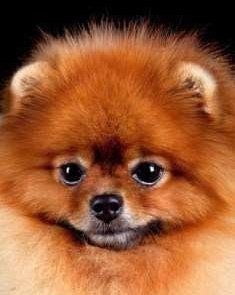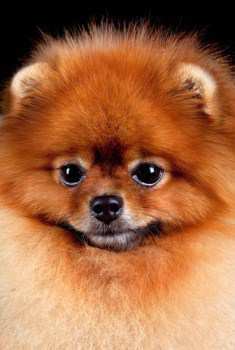Biting & Nipping
PetPom

The
Pomeranian
Information
Center
Biting Issues with a Pomeranian
Overview
It is rare for this breed to bite due to an aggression problem.
The foundation for biting often has its roots in a combination of play nipping (typical puppy behavior) and teething issues.
Without intervention it can develop into a habit.
Additionally, if an owner does not take proper steps to stop any sort of biting, the puppy will never truly learn that it is an unacceptable action.
Since Poms have sharp little teeth, small nips can hurt quite a bit, and things can get out-of-control rather quickly.
It is rare for this breed to bite due to an aggression problem.
The foundation for biting often has its roots in a combination of play nipping (typical puppy behavior) and teething issues. Without interference it can develop into a habit.
Additionally, if an owner does not take proper steps to stop any sort of biting, the puppy will never truly learn that it is an unacceptable action.
Since Poms have sharp little teeth, small nips can hurt quite a bit, and things can get out-of-control rather quickly.
Nipping Vs Biting
To be technical, what is most often seen with Pomeranians are nips, and not actual bites that are done in an overly aggressive manner. Nips are quick snaps, often in the air. Bites are serious actions in which jaws clamp down and blood may be drawn.
This section will focus more on nips.
If you happen to have a Pom that is overly aggressive, this is a separate issue that is covered in our
Aggression section.
Reasons for Nipping and Biting
It is important to know if your Pomeranian is acting aggressive and biting due to a medial issue or if the answer lies somewhere else.
Illness or Injury
An otherwise calm and even-tempered Pomeranian may nip at those who go near him or her if the dog is in pain
or feeling ill. When dogs are ill or in discomfort, they can feel threatened (yes, even by family members) and will often protect their resting area and themselves if people get too close.
A dog that does not feel well will often retreat. This will be to his sleeping area or an out-of-the way spot. If humans encroach upon this space, this is when the dog may nip. It is completely a self-protection reaction.
Other times, such as with luxating patella, hip dysplasia or collapsed trachea, a Pom may behave just fine, however when an owner reaches down to pick up the dog, it is then that the Pom will nip (and often let out a growl).
This is because the action of picking up the Pom puts pressure on the sensitive, injured area.
Illness or Injury
An otherwise calm and even-tempered Pomeranian may nip at those who go near him or her if the dog is in pain
or feeling ill. When dogs are ill or in discomfort, they can feel threatened (yes, even by family members) and will often protect their resting area and themselves if people get too close.
A dog that does not feel well will often retreat. This will be to his sleeping area or an out-of-the way spot. If humans encroach upon this space, this is when the dog may nip. It is completely a self-protection reaction.
Other times, such as with luxating patella, hip dysplasia or collapsed trachea, a Pom may behave just fine, however when an owner reaches down to pick up the dog, it is then that the Pom will nip (and often let out a growl). This is because the action of picking up the Pom puts pressure on the sensitive, injured area.


These types of injuries often only hurt just at the moment that the knee cap or hip joint slips out of place.
Sometimes. it is not for 2 or 3 days later, once swelling has set in, that certain movements can cause pain. This includes: putting on collar or harness, picking the dog up, re-positioning the dog.
For this issue, often the biting is a quick nip into the air, it does not often make skin contact as it is a warning as if to say, "Please don't touch me!"
Teething
If your Pomeranian is in good health, there are other reasons why he may bite. When a puppy age 4 to 9 months is biting, the most common reason is teething. This can be a difficult and frustrating time for both of you. This is a form of nipping, as it is not done in an aggressive way.
Often, puppies will nip at hands and fingers when an owners tries to handle them or pick them up.
The fix for this is 2-fold.
1 - You will want to address the biting by showing your Pomeranian that it is not acceptable. This is done by:
- In a firm voice say 'No' or 'Ouch' (even if it does not hurt), while quickly pulling your hand (or other body part that was nipped) away
- Offer a quality chew toy or an ice treat that will sooth itchiness and sore gums that caused the nipping to occur
- Move away several feet to create distance
- Ignore the Pom (completely, no talking, no eye contact) for 5 minutes
- Give praise (after those 5 minutes) if the pup is chewing on his or her toys or crunching on the ice
2-
If a chew toy doesn't encourage play or offer oral benefits, a Pom will not bother to gnaw away on it. So, you will want to be sure to carefully select a few effective teething toys.
it is recommended to have several different types (strong rubber with nubs and soft ropes). This is because one day his gums may be sore and a soft chew is what is desired, other days there may be a strong urge to crunch on something and that desire must be addressed as well.
When a dog has healthy options, he will be less prone to gnaw on furniture or nip at hands. Putting toys into the freezer to make them cold can offer extra relief.
Improper Hierarchy and Lack of Rules
All dogs, regardless of their breed, see the world from a canine perspective. And how they see it is that within the den (house) lives the pack (family, both humans and animals). And of that group, there is an Alpha (the leader) and everyone else are the Betas (followers).
Rules of the pack dictate that if a member commits an infraction, he will be banned from the pack; either temporarily to teach a lesson, or permanently if the action was severe enough.
In addition, dogs look to their leaders to teach right and wrong.
Training a Pomeranian to Stop Nipping and Biting
*
Nipping due to teething is a separate issue, so if your Pom is a pup and is in the teething phase, go back to Reasons for Nipping - Teething.
Things to keep in mind before you do the training:
1)
Despite stereotypes, it is not true that all small toys dogs such as the Pomeranian are 'snappy'. This sort of behavior is in no way a 'breed trait'.
The Pom breed's ancestors originated in cold climates as they were sled-pulling dogs whose average size
was 30 pounds. Over time, they have become smaller dogs, but this did not make them biters.
2)
A Pomeranian will usually continue any behavior in which he receives some type of satisfaction (attention is given, etc.) unless he is trained that negative outcomes for an action exceed any possible benefit.
3)
To train your Pom to stop nipping or biting, this should be performed in a calm and controlled manner.
Never scold or yell at your dog, as all you will accomplish to to teach your Pom to be afraid of you. Adding fear or stress to the equation on exasperates the problem.
When a Pom learns to fear his owner, nothing is gained and much is lost, including that wonderful bond and relationship between human and canine.
To start the training:
Keeping this in mind what we have discussed regarding the need for proper hierarchy, the goal will be to:
A)
Take charge as leader.
And B)
Then train your Pom via temporarily banning the puppy or dog if they nip, bite, or otherwise display unacceptable behavior.
To take charge as leader:
You will want to make it clear, in a loving way, that you are in charge. When this is understood, your Pomeranian will think twice about nipping at you, because dogs rarely nip at their leader.
This is done by consistently following these rules:
- The Pom must obey a 'Sit' command any time that food is given; this includes both meals and snacks.
- When leaving the house or coming back in, humans go first, followed by the dog.
- For dogs that really need the idea driven home, stay on a physically higher level than your Pom. This means that you do not sit on the floor with him, and he does not sit up on the sofa with you.
Once that has been established, the order of training is:
1.
Give a sharp 'No' and immediately distance yourself from your dog.
2.
Immediately place your Pom in a time-out. This is best done in his indoor playpen
and it should be placed where he can see the family. After all, if he cannot see that others are carrying on, how will he know that he is being 'banished'?
During this short time, he must be 100% ignored. Zero talking, zero eye contact. No interaction at all.
3.
Continue this until your dog has noticed. You will see that he becomes a bit whiny and may pace. It is at this time that his mind is metaphorically thinking, "Did I do something wrong to be ignored by my pack leader? Oh, no, no one is noticing that I'm here ... am I being banished?"
4.
Allow him to come out. After a few minutes, allow for casual contact and interaction. There will be no praising or patting yet. However, an owner may speak out loud, etc.
5.
If the Pom nips again, immediately go to Step 1.
6.
If the Pom behaves, offer great praise and a treat.
It can take days to weeks for a dog to learn to stop biting; however once the training is complete, treats will not need to be given for good behavior; though occasionally vocal praise will encourage a dog to continue behaving nicely.
You May Also Like:
Carry options for Pomeranians
- Some great choices for when you're out and about with your Pom.
Best Shampoos and Coat Care for a Pomeranian
- The products that you use will have a huge effect on how your Pom looks.
If you email photos to us, you agree that PetPom is given free copyright to use at our discretion. We will always credit the photo to the name of the Pom's owner(s) if it is supplied.
Email: Contact@PetPom.com
All text, images and artwork protected by US and International copyright laws. All rights reserved. Copyright PetPom.com
We are a participant in the Amazon Services LLC Associates Program, an affiliate advertising program designed to provide a means for us to earn fees by linking to Amazon.com and affiliated sites.


